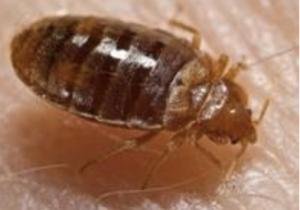Heteroptera and bed bugs
Last edited on : 22/09/2024

Heteroptera are insects with biting mouthparts. Most are ecto-parasites of plants, but some have evolved to predate other insects or ecto-parasitize vertebrate animals (hematophagy). Their infestations, which were very frequent (almost ubiquitous) before the massive use of pesticides, have been on the increase over the last two decades.
Species that parasitize humans
Reduvide family
This family includes hematophagous bugs at all stages of development (triatomines) and predatory bugs (reduvines).
The triatomine bugs of South and Central America are of medical importance: parasitizing vertebrates, they can bite humans and transmit an endo-parasite (trypanosoma cruzi) responsible for Chagas disease. These yellow, red and black bugs are active at night, hiding in nooks and crannies during the day. Their bite is painless, and the bite lasts a few minutes, after which they emit liquid excrement onto the skin. It is these droppings that are rich in trypanozomes, and humans become infected either by direct contact of the droppings with mucous membranes or by scratching lesions.
Cimicide family (cimex)
This family includes hematophagous bugs at all stages of development, highly resistant to fasting, swift, active at night, hiding in nooks and crannies during the day, and capable of parasitizing various vertebrates, including man. Their sting is painless but rapidly pruritic. When they are very numerous, a nauseating odor can be perceived.
The archetypal are "bed bugs" : Cimex lectularius (in temperate countries) and Cimex hemipterus (mainly in tropical countries), lenticular insects (flat and rounded), yellow to reddish-brown in color, adult size 3 to 5 mm. They do not transmit disease.
Other species
Many other species of heteroptera can "accidentally" bite humans. They are not, however, of significant importance.
Infestation modes and epidemiology
Contrary to popular belief, infestation herself is not linked to hygiene conditions.
Infestation can be active (the insect moves around at night to feed, attracted by heat and CO2, and spreads to nearby dwellings) or passive (if you stay in an infested area, bedbugs will hide in luggage and clothing). High-traffic areas (hotels, cinemas, schools, nurseries, stations, airports, etc.) are particularly at risk.
In addition, dwellings with cob walls (more common in tropical countries) offer particularly favorable housing conditions for heteroptera.
The prevalence of heteroptera has varied considerably over time. However, they were virtually ubiquitous until the widespread agricultural and domestic use of insecticides after the Second World War. First came DDT (to which bedbugs became resistant), then organophosphates, carbamates and pyrethroids. In the second half of the twentieth century, the prevalence of bedbugs declined sharply.
However, awareness of the serious toxicity of insecticides to humans has led most countries, particularly in the West, to increasingly restrict their use over the last few decades... which has been accompanied by a "return of the bedbugs".
More recently, the heat waves experienced worldwide as a result of global warming are encouraging the proliferation of bedbugs in temperate countries in summer. An increase in temperature of 20 to 25°C for a few weeks is enough to double their reproduction cycle. On a more limited scale, global warming is also encouraging the gradual spread of triatomine bugs and Chagas disease in the Americas.
The proliferation of "airbnb"-type rentals in residential buildings, particularly in major tourist cities, is also a factor favoring the multiplication of infestation outbreaks.
Finally, the increase in international travel, particularly "north-south" since the 1990s, has often been incriminated as a factor favoring this re-emergence. However, this remains only a hypothesis that has not been confirmed, as infestations are still mainly due to local species.
Clinical diagnosis
Diagnosis is based exclusively on observation of bedbugs at the site of infestation, and clinical recognition of skin lesions, which are nonetheless not very specific in appearance. Lesions can take on a variety of appearances (macules, bullae, hemorrhages, papular urticaria), but are most often erythematous papules, discreetly edematous and always highly pruritic. They are usually grouped in rows or clusters.
In South and Central America, Chagas disease is transmitted by triatomines.
Treatment and eradication
With the exception of triatomine-transmitted Chagas disease, heteroptera bites require no treatment. Occasionally, topical corticoids or oral anti-histamines are prescribed in the case of extensive, highly pruritic lesions.
Home eradication of bedbugs, on the other hand, is difficult. Ideally, it should be rapid (the number of bedbugs and the places affected are still limited) and carried out by a specialized company using a combination of physical and chemical methods. "Light" measures (vacuuming, high-temperature washing of clothes and bedding, steam cleaning of mattresses, etc.) are generally insufficient and should only be recommended as a "preparation" for true eradication. Insecticides should only be used by a specialized company. Eradication requires at least two treatments at intervals of +- 4 weeks.
In addition, eradication must be carried out in all affected dwellings (often the whole building, sometimes neighbouring buildings), otherwise rapid re-infestation may occur through proximity.
In most countries, eradication is the responsibility of the homeowner(s), to whom the costs are charged.
Bibliography
Association française des enseignants de parasitologie et mycologie, Parasitologie - Mycologie, ANOFEL, 2002
Elston DM, Bedbugs, UpToDate, 2022
Perron S et al., Les punaises de lit, retour vers le futur, Institut National de Santé Publique du Quebec, janv 2010